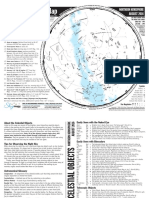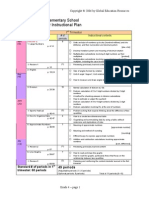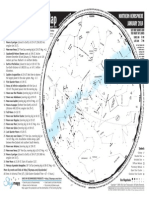The Evening Sky Map: September 2013
The Evening Sky Map: September 2013
Uploaded by
3582Copyright:
Available Formats
The Evening Sky Map: September 2013
The Evening Sky Map: September 2013
Uploaded by
3582Original Title
Copyright
Available Formats
Share this document
Did you find this document useful?
Is this content inappropriate?
Copyright:
Available Formats
The Evening Sky Map: September 2013
The Evening Sky Map: September 2013
Uploaded by
3582Copyright:
Available Formats
SEPTEMBER 2013
RI
r
Co oli
r
Ca
M9
NO
ST
AL
IS
AR
le
ub er
Do lust
C
Polaris
NCP
Lit
Dip tle
per
M3
RT
UR
MINSA
OR
ub
Th
TH
CO
M5
an
& Miza
Al r
co
r
R
D
urus
Arct
65
CH
46
IC
M22
SAG I T TA R I U S
M6
M7
AB
RIG
Th e
HT S
US
Su m
CORONA
AUSTRALIS
ead.
HT
NIG
he
T
Te a h e
po
t
GR
Symbols
Galaxy
Double
Star
S
U
PI
Variable
Star
s
OR
C
y
S
Wa IT
Diffuse Nebula
l k y AS
i
e M I ZO N
Planetary Nebula
Th
OR
-H
Open
Star Cluster
O
T
ON
Globular
Star Cluster
RI Z
O
H
sa
M8
AP
tc
Nun
k
23
1M
0
M2
cro
M2
M4
US
M1
M25
An
ta
re
s
RN
0 M
12
IU
H
OP
ICO
M5
SERPE
( C A P UN S
T)
HERCULES
RA
LY
M57
ireo
M1
PR
Gemma
Vega
M13
M92
Et
am
CORONA
BOREALIS
in
Alb
CE
RD
M82
LA
M1
ON
PA
CA
93
S
(C ERP
AU EN
DA S
)
AR
LO
g le
PE
ME
33
(Add 1 Hour For Daylight Saving)
PO
SU
an
e r T ri
A
M2
AU PI
ST SCI
RI S
NU
S
fi
US sh,
P is
IN
c
G
TH is A
ust
ES
ri n
KY
us
MA
PT .
OF
I ND
http://Skymaps.com/store
All sales support the production and free distribution of The Evening Sky Map.
ES I
N TIC
C AN A
VE
Th
Di e B
pp ig
er
G
Summ
EG
Altair
BOTES
is
ss
LIB
lar
th
RA
es
P o . CEL
d
RT
ky
n
N
fi
.
AI
ZO
N D Anc
to
RI
4
ien
h)
M6
AT
HO
tp
ES
o u g TH E
l
P
o
VIRGO
AN
e ts
or
IS
DT
er (
I ME i d e n tif
C LE
ip p
ie d
CIR
S. T
ig D
R
B
it as
E
e
HE
h
UT
WEST
the
CE N
U se t
ro ad o
HE O
TE R
f the g od
ND T
OF T
s .
HE M
H) A
T
I
N
E
AP IS T
E AD ( Z
HE PART OF
THE SKY DIRECTLY OVERH
h
,t
N
T
CY
61
P
NU
tr e
s
ar R
st
A
h t AP
rig
M
e b SKY
Th
E
TH
RN
M81
ne
b
De
M3
Great Square
of Pegasus
ge
Star Charts & Astro Posters
Telescopes & Binoculars
rt h
N o OB
AL
TI
ES
CA
S
HI
SKY MAP SHOWS HOW
THE NIGHT SKY LOOKS
EARLY SEPT 9 PM
LATE SEPT 8 PM
SKY MAP DRAWN FOR
A LATITUDE OF 40
NORTH AND IS
SUITABLE FOR
LATITUDES UP
TO 15 NORTH
OR SOUTH
OF THIS
M3
EDA
US
SA
TU
R
EU
ROM
let
St
a
UR
r.
AJ
O
PH
AND
C i rc
RI
Fo
au
AR
) .
ella
CE
CASSIOPEIA
M33
72
ma
lh
TS
R TH
Cap
Al
go
l
LP
39
66
UA
JE
C
EL
O
CA
T
LY N X
U
DE
700
BY
ED
SE
M1
if
Cr
M11
lar
ER
En
M27
AQUILA
NORTHERN HEMISPHERE
EN
P
S
Star Atlases & Planispheres
Books for Sky Watchers
IN
AQ
SAVE ON RECOMMENDED PRODUCTS
EG
of
Moon near Mars (37 from Sun, morning sky) at 5h UT. Mag. +1.6.
Moon near Beehive Cluster (33 from Sun, morning sky) at 16h UT.
Moon near Regulus (12 from Sun, morning sky) at 11h UT.
New Moon at 11:35 UT. Start of lunation 1122.
Venus 1.6 NNE of Spica (40 from Sun, evening sky) at
4h UT. Mags. 4.0 and +1.0.
8 Moon, Venus and Spica within circle diameter 3.3
(32 from Sun, evening sky) at 15h UT.
8 Moon very near Spica (evening sky) at 16h UT.
8 Mars 0.2 S of Beehive Cluster (39 from Sun,
morning sky) at 22h UT. Mag. +1.6.
8 Moon very near Venus (41 from Sun, evening sky)
at 22h UT. Mag. 4.1. Spectacular occultation
visible from southeast South America.
9 Moon near Saturn (51 from Sun, evening sky) at
18h UT. Mag. +0.7.
11 Moon near Antares (evening sky) at 23h UT.
12 First Quarter Moon at 17:09 UT.
15 Moon at perigee (closest to Earth) at 17h UT
(367,391 km; angular size 32.5').
18 Venus 3.5 SSW of Saturn (43 from Sun, evening
sky) at 16h UT. Mags. 4.1 and +0.7.
19 Full Moon at 11:12 UT.
22 September equinox at 20:44 UT. The time when the
Sun reaches the point along the ecliptic where it
crosses into the southern celestial hemisphere marking
the start of autumn in the Northern Hemisphere and
spring in the Southern Hemisphere.
24 Moon near the Pleiades (morning sky) at 6h UT.
27 Last Quarter Moon at 3:55 UT.
25 Mercury 0.7 NNE of Spica (22 from Sun, evening sky) at
1h UT. Mags. 0.1 and +1.0.
25 Moon near Aldebaran (112 from Sun, morning sky) at 2h UT.
27 Moon at apogee (farthest from Earth) at 18h UT (distance 404,308
km; angular size 29.6').
28 Moon near Jupiter (77 from Sun, morning sky) at 6h UT. Mag. 2.2.
More sky events and links at http://Skymaps.com/skycalendar/
All times in Universal Time (UT). (USA Eastern Summer Time = UT 4 hours.)
PISCES
of
Ham
h
a
l
C
ut B
OU as s
i
m o CE .
N
o
AR
pe
D
e
IE
i
th
I
FA
a
S
T
o
S
U
CE f o r m
in t
YO
NT
ar
a
AT
E
W
aj
R(
a
TH
-sh
N
J
om
phd
C
US
i
a
U
T
D
p
S
PTI
r fr CTIO
e
CE
T
t
A
E
h
ECLI
a te
a
S
t
Y
g w E DI R
i
O
s
U
e
rin
a
H
s
A
y
p ou
RE
ST
t
o
an
D
r
EA
ec
O
gm
o
I
N
g
n
SAM
G
i
z
you n
e
N
EAST
.
OW
THE
ts a
)
S
p re se n
P IS
O
T
h
T
e
H
a
n
cient constellation of Aquarius re
E MA
E C OM
OF TH
PASS D
OTTOM
IRECTION
THAT APPEARS ALONG THE B
2
2
4
5
6
Get Sky Calendar on Twitter
http://twitter.com/skymaps
CO
WE
Sky Calendar September 2013
S.
BE
T
FREE* EACH MONTH FOR YOU TO EXPLORE, LEARN & ENJOY THE NIGHT SKY
KY
HE
Fro
NO
m
Z
E
n
LE
N
o
I
r
t
TH
MP
h
).
e
r
n
A
EXA
l
N
( NCP
a
NORTH
t
D
i
t
u
F OR
TH
de
l Pole
s
E
,
s
LE (
t
H
a
rs
e l e st i a
O
a
R
p
p
C IR C
e
I
a
r
Z
t
o rotate around the North C
ON . C
R IZ O N
OMPAS
THE HO
S DIRECTIO
NS ARE INDICATED ALONG
The Evening Sky Map
.S
W
AP
SKY
F RO
Star Magnitudes
m er
SOUTH
-1 0
1
2
3
4
T ri an g
verh
RE
TAR
le V eg
ta r s o
E NT I
PATT
a, Altair, and Deneb three bright s
THE
E RN I
S
Copyright
20002013
Kym
Thalassoudis.
All
Rights
Reserved.
W
N THE S
AP SHO
KY.
INSTRUCTIONS: THE SKY M
* TERMS OF USE: FREE FOR NON-COMMERCIAL EDUCATIONAL USE. ASTRONOMY EDUCATION GROUPS
MAY FREELY DISTRIBUTE PRINTED HANDOUTS. FULL DETAILS AT http://Skymaps.com/terms.html
Tips for Observing the Night Sky
When observing the night sky, and in particular deep-sky objects such as star clusters,
nebulae, and galaxies, its always best to observe from a dark location. Avoid direct
light from street lights and other sources. If possible observe from a dark location
away from the light pollution that surrounds many of todays large cities.
You will see more stars after your eyes adapt to the darknessusually about 10 to
20 minutes after you go outside. Also, if you need to use a torch to view the sky
map, cover the light bulb with red cellophane. This will preserve your dark vision.
Finally, even though the Moon is one of the most stunning objects to view
through a telescope, its light is so bright that it brightens the sky and makes many of
the fainter objects very difficult to see. So try to observe the evening sky on
moonless nights around either New Moon or Last Quarter.
Astronomical Glossary
Conjunction An alignment of two celestial bodies such that they present the least
angular separation as viewed from Earth.
Constellation A defined area of the sky containing a star pattern.
Diffuse Nebula A cloud of gas illuminated by nearby stars.
Double Star Two stars that appear close to each other in the sky; either linked by
gravity so that they orbit each other (binary star) or lying at different distances from
Earth (optical double). Apparent separation of stars is given in seconds of arc (").
Ecliptic The path of the Suns center on the celestial sphere as seen from Earth.
Elongation The angular separation of two celestial bodies. For Mercury and Venus
the greatest elongation occurs when they are at their most angular distance from the
Sun as viewed from Earth.
Galaxy A mass of up to several billion stars held together by gravity.
Globular Star Cluster A ball-shaped group of several thousand old stars.
Light Year (ly) The distance a beam of light travels at 300,000 km/sec in one year.
Magnitude The brightness of a celestial object as it appears in the sky.
Open Star Cluster A group of tens or hundreds of relatively young stars.
Opposition When a celestial body is opposite the Sun in the sky.
Planetary Nebula The remnants of a shell of gas blown off by a star.
Universal Time (UT) A time system used by astronomers. Also known as Greenwich
Mean Time. USA Eastern Standard Time (for example, New York) is 5 hours behind UT.
Variable Star A star that changes brightness over a period of time.
SEPTEMBER 2013
CELESTIAL OBJECTS
Listed on this page are several of the brighter, more interesting celestial objects
visible in the evening sky this month (refer to the monthly sky map). The objects are
grouped into three categories. Those that can be easily seen with the naked eye (that
is, without optical aid), those easily seen with binoculars, and those requiring a
telescope to be appreciated. Note, all of the objects (except single stars) will
appear more impressive when viewed through a telescope or very large
binoculars. They are grouped in this way to highlight objects that can be seen using
the optical equipment that may be available to the star gazer.
NORTHERN HEMISPHERE
About the Celestial Objects
Easily Seen with the Naked Eye
Altair
Capella
Arcturus
Cephei
Deneb
Herculis
Vega
Algol
Fomalhaut
Antares
Polaris
Aql
Aur
Boo
Cep
Cyg
Her
Lyr
Per
PsA
Sco
UMi
Brightest star in Aquila. Name means "the flying eagle". Dist=16.7 ly.
The 6th brightest star. Appears yellowish in color. Spectroscopic binary. Dist=42 ly.
Orange, giant K star. Name means "bear watcher". Dist=36.7 ly.
Cepheid prototype. Mag varies between 3.5 & 4.4 over 5.366 days. Mag 6 companion.
Brightest star in Cygnus. One of the greatest known supergiants. Dist=1,400200 ly.
Semi-regular variable. Magnitude varies between 3.1 & 3.9 over 90 days. Mag 5.4 companion.
The 5th brightest star in the sky. A blue-white star. Dist=25.0 ly.
Famous eclipsing binary star. Magnitude varies between 2.1 & 3.4 over 2.867 days.
Brightest star in Piscis Austrinus. In Arabic the "fish's mouth". Dist=25 ly.
Red, supergiant star. Name means "rival of Mars". Dist=135.9 ly.
The North Pole Star. A telescope reveals an unrelated mag 8 companion star. Dist=433 ly.
Easily Seen with Binoculars
M31
M2
Aquilae
M3
Cephei
Cygni
M39
Draconis
M13
M92
Lyrae
R Lyrae
M10
IC 4665
6633
M15
Double Cluster
M8
M25
M22
M6
M7
Mizar & Alcor
Cr 399
And
Aqr
Aql
CVn
Cep
Cyg
Cyg
Dra
Her
Her
Lyr
Lyr
Oph
Oph
Oph
Peg
Per
Sgr
Sgr
Sgr
Sco
Sco
UMa
Vul
The Andromeda Galaxy. Most distant object visible to naked eye. Dist=2.93 million ly.
Resembles a fuzzy star in binoculars.
Bright Cepheid variable. Mag varies between 3.6 & 4.5 over 7.166 days. Dist=1,200 ly.
Easy to find in binoculars. Might be glimpsed with the naked eye.
Herschel's Garnet Star. One of the reddest stars. Mag 3.4 to 5.1 over 730 days.
Long period pulsating red giant. Magnitude varies between 3.3 & 14.2 over 407 days.
May be visible to the naked eye under good conditions. Dist=900 ly.
Wide pair of white stars. One of the finest binocular pairs in the sky. Dist=100 ly.
Best globular in northern skies. Discovered by Halley in 1714. Dist=23,000 ly.
Fainter and smaller than M13. Use a telescope to resolve its stars.
Famous Double Double. Binoculars show a double star. High power reveals each a double.
Semi-regular variable. Magnitude varies between 3.9 & 5.0 over 46.0 days.
3 degrees from the fainter M12. Both may be glimpsed in binoculars. Dist=14,000 ly.
Large, scattered open cluster. Visible with binoculars.
Scattered open cluster. Visible with binoculars.
Only globular known to contain a planetary nebula (Mag 14, d=1"). Dist=30,000 ly.
Double Cluster in Perseus. NGC 869 & 884. Excellent in binoculars. Dist=7,300 ly.
Lagoon Nebula. Bright nebula bisected by a dark lane. Dist=5,200 ly.
Bright cluster located about 6 deg N of "teapot's" lid. Dist=1,900 ly.
A spectacular globular star cluster. Telescope will show stars. Dist=10,000 ly.
Butterfly Cluster. 30+ stars in 7x binoculars. Dist=1,960 ly.
Superb open cluster. Visible to the naked eye. Age=260 million years. Dist=780 ly.
Good eyesight or binoculars reveals 2 stars. Not a binary. Mizar has a mag 4 companion.
Coathanger asterism or "Brocchi's Cluster". Not a true star cluster. Dist=218 to 1,140 ly.
Telescopic Objects
Andromedae
7009
7293
Arietis
Botis
M51
Cassiopeiae
Albireo
61 Cygni
Delphini
Lyrae
M57
M20
M17
M11
M16
M33
M27
And
Aqr
Aqr
Ari
Boo
CVn
Cas
Cyg
Cyg
Del
Lyr
Lyr
Sgr
Sgr
Sct
Ser
Tri
Vul
Attractive double star. Bright orange star with mag 5 blue companion. Sep=9.8".
Saturn Nebula. Requires 8-inch telescope to see Saturn-like appendages.
Helix Nebula. Spans nearly 1/4 deg. Requires dark sky. Dist=300 ly.
Impressive looking double blue-white star. Visible in a small telescope. Sep=7.8".
Red giant star (mag 2.5) with a blue-green mag 4.9 companion. Sep=2.8". Difficult to split.
Whirlpool Galaxy. First recognised to have spiral structure. Dist=25 million ly.
Yellow star mag 3.4 & orange star mag 7.5. Dist=19 ly. Orbit=480 years. Sep=12".
Beautiful double star. Contrasting colours of orange and blue-green. Sep=34.4".
Attractive double star. Mags 5.2 & 6.1 orange dwarfs. Dist=11.4 ly. Sep=28.4".
Appear yellow & white. Mags 4.3 & 5.2. Dist=100 ly. Struve 2725 double in same field.
Eclipsing binary. Mag varies between 3.3 & 4.3 over 12.940 days. Fainter mag 7.2 blue star.
Ring Nebula. Magnificent object. Smoke-ring shape. Dist=4,100 ly.
Trifid Nebula. A telescope shows 3 dust lanes trisecting nebula. Dist=5,200 ly.
Omega Nebula. Contains the star cluster NGC 6618. Dist=4,900 ly.
Wild Duck Cluster. Resembles a globular through binoculars. V-shaped. Dist=5,600 ly.
Eagle Nebula. Requires a telescope of large aperture. Dist=8,150 ly.
Fine face-on spiral galaxy. Requires a large aperture telescope. Dist=2.3 million ly.
Dumbbell Nebula. Large, twin-lobed shape. Most spectacular planetary. Dist=975 ly.
The Evening Sky Map (ISSN 1839-7735) Copyright 20002013 Kym Thalassoudis. All Rights Reserved.
You might also like
- Grade 6: Module 1: Unit 1: Lesson 11: Selecting Evidence: "The Hero's Journey" and TheDocument13 pagesGrade 6: Module 1: Unit 1: Lesson 11: Selecting Evidence: "The Hero's Journey" and TheXavier McCulloughNo ratings yet
- Greek Latin Roots Revised For 4thDocument15 pagesGreek Latin Roots Revised For 4thNiki Eskew Turco100% (1)
- Sky MapsDocument2 pagesSky MapsPatrick SchwartzNo ratings yet
- Math 2 Times Table, Place Value and Decimals: Grades 3 - 4Document25 pagesMath 2 Times Table, Place Value and Decimals: Grades 3 - 4kenneth anthony casquejo100% (1)
- Grade 4: Mathematics For Elementary School, One-Year Instructional PlanDocument4 pagesGrade 4: Mathematics For Elementary School, One-Year Instructional PlanShawanda ClarkNo ratings yet
- My New DogDocument4 pagesMy New Dogapi-473539300No ratings yet
- September 8-11th 2020 Week 4 NewsletterDocument1 pageSeptember 8-11th 2020 Week 4 Newsletterapi-262035795No ratings yet
- Summer8math Package PDFDocument34 pagesSummer8math Package PDFAnonymous EmjOwXNo ratings yet
- St. Patricks Day Kids Craft Leprechaun HatDocument2 pagesSt. Patricks Day Kids Craft Leprechaun HatMiguel BlanchNo ratings yet
- Third Grade PacingQ3Document3 pagesThird Grade PacingQ3alv6378No ratings yet
- Hess Back-To-School NightDocument15 pagesHess Back-To-School Nightapi-169356446No ratings yet
- Summary Sentence FramesDocument1 pageSummary Sentence Framesapi-296621128No ratings yet
- Free Area & Perimeter Task Cards: Promoting Success For You and Your Students!Document11 pagesFree Area & Perimeter Task Cards: Promoting Success For You and Your Students!api-507043127No ratings yet
- Arrays To AreaDocument26 pagesArrays To Areaapi-259478148No ratings yet
- The Stone Age: 100 Words To DescribeDocument1 pageThe Stone Age: 100 Words To Describepatricia.bucci.mailNo ratings yet
- Inventors at WorkDocument70 pagesInventors at Workali.mosaad1996100% (1)
- Lesson Plan 11IIDocument241 pagesLesson Plan 11IIlongpham_dhnnNo ratings yet
- Fluency Folder FreebieDocument4 pagesFluency Folder FreebieKimberli Sollenberger MaultsbyNo ratings yet
- Number of The Day TemplateDocument1 pageNumber of The Day Templateapi-283723776No ratings yet
- WeeklyDocument4 pagesWeeklyapi-354338267No ratings yet
- The Wild Robot: Grade 4 Reading ComprehensionDocument1 pageThe Wild Robot: Grade 4 Reading Comprehensioneka.nakhutsrishviliNo ratings yet
- Fry Words List AssessmentDocument10 pagesFry Words List AssessmentZabrinaNo ratings yet
- 3rd Grade Writing2Document1 page3rd Grade Writing2islandteacherNo ratings yet
- Grade 5 Lesson 1 Comparing Text Structures - Chronology and Problem-SolutionDocument8 pagesGrade 5 Lesson 1 Comparing Text Structures - Chronology and Problem-SolutionWidian SweidanNo ratings yet
- FreereadingpassagesforfluencyandcomprehensionDocument10 pagesFreereadingpassagesforfluencyandcomprehensionapi-346639341No ratings yet
- 4m1c Fractions-With-Pattern-BlocksDocument13 pages4m1c Fractions-With-Pattern-Blocksapi-278966773No ratings yet
- Leveled Reading Center Task CardsDocument6 pagesLeveled Reading Center Task CardsS TANCREDNo ratings yet
- Subject and Predicate Match FreeDocument8 pagesSubject and Predicate Match FreegilamadaNo ratings yet
- February Daily Practice PreviewDocument5 pagesFebruary Daily Practice PreviewjainNo ratings yet
- 4.NBT.6 Task Cards SampleDocument22 pages4.NBT.6 Task Cards SampleTitis Nur WidiawatiNo ratings yet
- Morning MeetingDocument9 pagesMorning Meetingapi-539944028No ratings yet
- Math Spiral Reviews Part1Document10 pagesMath Spiral Reviews Part1api-239745334No ratings yet
- Writing Choice BoardDocument3 pagesWriting Choice Boardapi-503734081No ratings yet
- Stubbington Rti LiteracyDocument2 pagesStubbington Rti Literacyapi-420601149No ratings yet
- Unit 1 English Interactive Notebook: Family Descriptions Character PhysicalDocument1 pageUnit 1 English Interactive Notebook: Family Descriptions Character PhysicalRaquel MartinezNo ratings yet
- This Is MyDocument4 pagesThis Is Myapi-369830845No ratings yet
- Early Finishers Choice BoardDocument1 pageEarly Finishers Choice BoardKathleen JonesNo ratings yet
- Reading Winn-Dixie Unit PlanDocument11 pagesReading Winn-Dixie Unit Planapi-480223442No ratings yet
- Social Studies Imb Lesson PlanDocument7 pagesSocial Studies Imb Lesson Planapi-312372901No ratings yet
- 4th Grade Opinion WritingDocument3 pages4th Grade Opinion Writingapi-359051210No ratings yet
- Sol Solecito Luna Lunera Lotto LaraDocument2 pagesSol Solecito Luna Lunera Lotto Laraapi-340818289No ratings yet
- Book PDFDocument74 pagesBook PDFCDaniela GuevaraQNo ratings yet
- Noun Hunt People Places ThingsDocument1 pageNoun Hunt People Places ThingsVicente LaoNo ratings yet
- SummarizingSleuths 1Document25 pagesSummarizingSleuths 1Aaron Swiniuch100% (2)
- Independent Reading Level Benchmarks 12 2012 - Teacher CollegeDocument1 pageIndependent Reading Level Benchmarks 12 2012 - Teacher Collegeapi-257553996No ratings yet
- Beginning Opinion WritingDocument20 pagesBeginning Opinion WritingLars HeleneNo ratings yet
- Org Pattern Task CardsDocument9 pagesOrg Pattern Task CardsEsmeralda CartagenaNo ratings yet
- Date/Topci Learning Outcomes/ACARA Link Process Resources: Maths Unit PlanDocument30 pagesDate/Topci Learning Outcomes/ACARA Link Process Resources: Maths Unit Planapi-471795964No ratings yet
- Mapping Words in Sounds BoxesDocument3 pagesMapping Words in Sounds BoxesmegbhicksNo ratings yet
- Sentences 5Document4 pagesSentences 5umaitNo ratings yet
- Grade 1 Sentence Unscramble BDocument2 pagesGrade 1 Sentence Unscramble BalespinaNo ratings yet
- Fluency Book ListDocument3 pagesFluency Book Listapi-239142349No ratings yet
- Winter Games 2018: Reading Comprehension PacketDocument7 pagesWinter Games 2018: Reading Comprehension PacketRania MohammedNo ratings yet
- Sight Word Bingo First PDFDocument9 pagesSight Word Bingo First PDFApril Degamo-ManglonaNo ratings yet
- Dibels8 Benchmark Maze 2 Scoring Key 2020-1Document19 pagesDibels8 Benchmark Maze 2 Scoring Key 2020-1Heena DeyNo ratings yet
- No Prep!: For Use With Google Classroom!Document3 pagesNo Prep!: For Use With Google Classroom!Pranshu PatniNo ratings yet
- Decodable Book Directions-4 1 1 1 - 3-6Document3 pagesDecodable Book Directions-4 1 1 1 - 3-6api-479279934No ratings yet
- Diagnostic ExampleDocument17 pagesDiagnostic Exampleapi-296055206No ratings yet
- The MagPi 2014 04 Issue 22Document48 pagesThe MagPi 2014 04 Issue 223582No ratings yet
- The MagPi 2014 12 Issue 29Document48 pagesThe MagPi 2014 12 Issue 293582No ratings yet
- The MagPi 2014 10 Issue 27Document48 pagesThe MagPi 2014 10 Issue 273582No ratings yet
- The MagPi 2014 05 Issue 23Document48 pagesThe MagPi 2014 05 Issue 233582No ratings yet
- Skymaps Com 2014 08Document2 pagesSkymaps Com 2014 083582No ratings yet
- Skymaps Com 2015 03Document2 pagesSkymaps Com 2015 033582No ratings yet
- Skymaps Com 2014 04Document2 pagesSkymaps Com 2014 043582No ratings yet
- The Evening Sky Map: JANUARY 2014Document2 pagesThe Evening Sky Map: JANUARY 20143582No ratings yet
- ARG Today 12Document18 pagesARG Today 123582No ratings yet
- Skymaps Com 2012 08Document2 pagesSkymaps Com 2012 083582No ratings yet
- Today: Chris Gleed - Owen, CGO EcologyDocument13 pagesToday: Chris Gleed - Owen, CGO Ecology3582No ratings yet
- ARG Today 7Document12 pagesARG Today 73582No ratings yet
- ARG Today 9Document14 pagesARG Today 93582No ratings yet
- ARG Amphibian ID Guide 2014Document6 pagesARG Amphibian ID Guide 20143582No ratings yet
- RocketSTEM Issue 9 2014Document84 pagesRocketSTEM Issue 9 20143582No ratings yet










































































